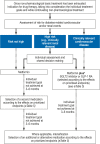Clinical Practice Guideline: Shared Decision Making, Diagnostic Evaluation, and Pharmacotherapy in Type 2 Diabetes
- PMID: 37874122
- PMCID: PMC10777312
- DOI: 10.3238/arztebl.m2023.0219
Clinical Practice Guideline: Shared Decision Making, Diagnostic Evaluation, and Pharmacotherapy in Type 2 Diabetes
Abstract
Background: Type 2 diabetes is one of the most important widespread diseases worldwide. In Germany, nearly one in five persons over age 65 has type 2 diabetes. The German National Disease Management Guideline for Type 2 Diabetes (NDMG; in German: Nationale Versorgungsleitlinie, NVL) contains updated recommendations for the diagnostic evaluation and pharmacotherapy of this disease as well as information about specific groups of people for whom early detection may be useful.
Methods: The guideline has been updated, chapter by chapter, since 2018. Its recommendations are based on systematically searched and evaluated scientific evidence, the clinical expertise of a multidisciplinary panel of experts, and patient perspectives.
Results: The new chapter on shared decision making includes a description of a structured approach that can be used when individual treatment goals have not been achieved. The diagnosis of diabetes newly requires at least two abnormally elevated laboratory values: e.g., fasting plasma glucose ≥ 126 mg/dL (≥ 7.0 mmol/L), HbA1c ≥ 6.5 % (≥ 48 mmol/mol) and/or casual plasma glucose ≥ 200 mg/dL (≥ 11.1 mmol/L). Cardiovascular and renal risks are to be considered in the choice of drug. Studies have shown that, in persons with cardiovascular disease, treatment with GLP-1 receptor agonists (GLP-1, glucagon-like peptide-1) or SGLT2 inhibitors (SGLT2, sodium-glucose co-transporter-2) was less likely than the comparison intervention to lead to certain patient-relevant endpoints, including all-cause mortality (OR = 0.88 and 0.84, respectively), hospitalization for heart failure (SGLT2 inhibitors: OR = 0.65), and worsening of renal function (OR = 0.61 and 0.59, respectively).
Conclusion: Current evidence continues to support the recommendations on pharmacotherapy of the 2021 guideline. The Guideline Group did not find evidence of adequate certainty to inform recommendations about the screening of persons at risk, HbA1c target values, or screening for sequelae and comorbidities. Better evidence on these matters would be desirable.
Figures




References
-
- Heidemann C, Scheidt-Nave C, Beyer A-K, et al. Gesundheitliche Lage von Erwachsenen in Deutschland - Ergebnisse zu ausgewählten Indikatoren der Studie GEDA 2019/2020-EHIS. J Health Monit. 2021;6:3–27.
-
- Bundesärztekammer (BÄK); Kassenärztliche Bundesvereinigung (KBV); Arbeitsgemeinschaft der Wissenschaftlichen Medizinischen Fachgesellschaften (AWMF) Nationale VersorgungsLeitlinie Typ-2-Diabetes - Langfassung, Version 3.0. www.doi.org/10.6101/AZQ/000503 (last accessed on 21 April 2023) - DOI
-
- Arbeitsgemeinschaft der Wissenschaftlichen Medizinischen Fachgesellschaften (AWMF) - Ständige Kommission Leitlinien. AWMF-Regelwerk Leitlinien: Version 2.0. www.awmf.org/leitlinien/awmf-regelwerk.html (last accessed on 22 March 2021)
-
- Guyatt G, Oxman AD, Akl EA, et al. GRADE guidelines: 1. Introduction—GRADE evidence profiles and summary of findings tables. J Clin Epidemiol. 2011;64:383–394. - PubMed
-
- Balshem H, Helfand M, Schünemann HJ, et al. GRADE guidelines: 3. Rating the quality of evidence. J Clin Epidemiol. 2011;64:401–406. - PubMed
Publication types
MeSH terms
Substances
LinkOut - more resources
Full Text Sources
Medical

